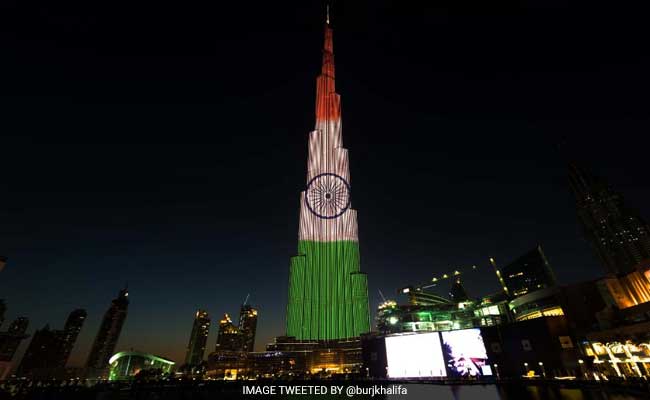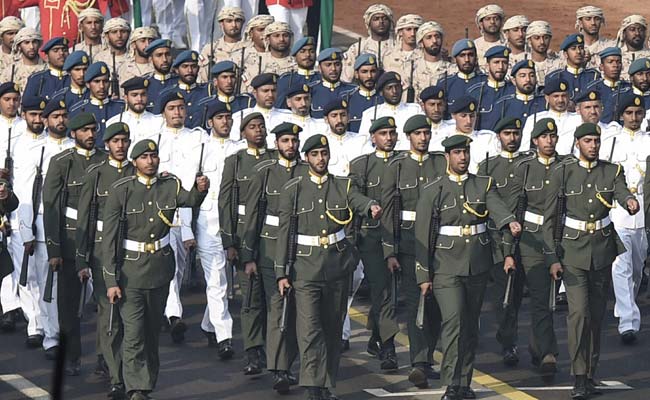Some would argue that the last comment is a very cynical take on India's earnest attempt to reinvent its troubled ties with the Gulf. These observers point to the Burj Khalifa, the world's tallest building located in Dubai, lit up in the colours of the Indian flag in honour of the visit to Delhi of the Crown Prince of Abu Dhabi Mohammed bin Zahed Al Nayhan as chief guest for yesterday's Republic Day parade.
As for how times have changed, note that as recently as 2012, a Hyderabad trial court had issued summons for the arrest of Mohamed Alabbar, the chairman of Emaar Properties, which also built the Burj Khalifa, and gave him only two weeks to be produced in court - until the Ministry of Home Affairs discreetly rapped the CBI on its knuckles and pointed out that that was a surefire way of destroying a relationship that was just beginning to climb out of its pro-Pakistani embrace.

PM Narendra Modi greets Abu Dhabi Crown Prince Mohammed bin Zayed Al Nahyan at the airport in Delhi
Proof lies in imitation which, some say, is the highest form of flattery. As soon as Burj Khalifa's decision to go Indian became an overnight sensation, the Abu Dhabi National Oil Company (ADNOC) decided to follow suit and colour its own building also in saffron, green and white. The Ashok Chakra was visible for miles around on both buildings.
In fact, ADNO, as part of a new deal, will fill half the underground cavern in Mangalore with oil crucial to India's plans for emergency reserves. The UAE is the fifth-largest supplier of crude to India.
Certainly, the UAE's 2.2 million Indians have played a major role in the re-transformation of this crucial tie between India and the Gulf. But unlike the influential Indian diaspora in the USA, who are American citizens in the first place and often embarrassed by India's poverty, the Gulf diaspora maintains very close ties with India. States like Kerala and Andhra Pradesh, especially, have been changed beyond recognition by the wealth generated in the Gulf.

The world's tallest skyscraper, Burj Khalifa, was light up in Indian tri-colour to mark the country's 68th Republic Day
A former chief of the UAE Naval Forces, Rear Admiral Ahmad Mohammed Al Sabha Al Tunaiji explained the evolving relationship to Gulf News: "The march (of the UAE soldiers on Rajpath) reflects the UAE's love towards India as a way of giving back. It tells how much we love this country, how much we trust them and how much we value them," he said.
"India's help before and after the unification of the Emirates was notable as Indians helped build this nation with their labour force, professionals, businessmen and traders ..." he added.
Al Tunaiji said that his father, like thousands of other Arabs, would sail to India, especially Calicut, to bring back precious spices. British India provided security from the 19th century onwards, while the Khoja and Kutchi communities of Gujarat ran trade and banking. The rupee was legal tender, while Indian stamps overlaid with the name of the emirate, were currency. Even after independence, the Arab elite would send their children to study in elite schools in India, like Mayo College in Ajmer, while Bombay was the heart of their social circuit.
A significant part of the strategic partnership between India and the UAE is a function of both sides looking for diversified relationships. The Gulf has been locked into an embrace with the US for years, depending on it for security, while Bhutto and then Zia-ul-Haq wooed the Arab sheikhs with the promise of bustard-hunting as well as defence training. Al Tunaiji, the former UAE naval chief, like scores of his fellow compatriots, was trained in the Pakistani naval academy.

Soldiers from the UAE led the Republic Day Parade at Rajpath
But something has been changing in recent years. As Pakistan's army and ISI began to run with the Al Qaeda and hunt with the Haqqani network in an attempt to expand influence in Afghanistan, the UAE became a target. Only a couple of weeks ago, five UAE diplomats were killed in Kandahar in an explosion. Dawood Ibrahim, who shifted base to both Pakistan and the UAE after the 1993 Mumbai blasts, is said to have been told by the UAE authorities to leave.
The UAE princes began to get increasingly uncomfortable with the Pakistani expatriate working class, especially if they seemed to be ultra-religious in intent and practice. UAE authorities in contrast welcomed the Indian working class, whether blue or white-collar, businessman or IT professional. A temple had been built in Dubai when Indira Gandhi visited in 1971; when Modi visited Abu Dhabi in 2015, the Crown Prince allocated land for another one in Abu Dhabi.
When the Uri attacks took place, the UAE was the first Islamic nation to criticize them. It also applauded the surgical strikes into Pakistan. Meanwhile, trade was growing in leaps and bounds and touches $50 billion today. Certainly, Modi has been quick to grasp the changes that were taking place. His sharpened political instinct allows him to see that India needs friends in the region - especially with the US retreating from global partnerships under Trump and China's Xi Jinping pushing to become Number One. So few observers were surprised when Modi went to the airport to greet the Abu Dhabi crown prince and flung himself into a tight embrace as soon as the Arab ruler descended from his plane. One hug, then two.
But Modi didn't stop there. All the other UAE princes descending from the plane were given the same hugging treatment. The Prime Minister was clear that he wasn't leaving anything to chance.
So what's that to do with the Uttar Pradesh election? The PM knows that UP's 18 per cent Muslims can swing several constituencies in what promises to be a closely fought contest over the coming month. He also knows that none of them are going to vote for the BJP - in fact, they are expected to strategically vote to defeat the BJP.
But what if the reciprocal show of affection with the powerful UAE rulers can change at least a few minds? Certainly the pictures of the UAE's leader clasping tightly the man who was once accused of failing to stop riots that killed more than a thousand Muslims in Gujarat, could send an important message. Whether or not the PM succeeds in his ambitious attempt to change the direction of the wind, the fact is that he is ambitious enough to try. That, in itself, makes him an interesting man to watch.
(Jyoti Malhotra has been a journalist for several years and retains an especial passion for dialogue and debate across South Asia.)
Disclaimer: The opinions expressed within this article are the personal opinions of the author. The facts and opinions appearing in the article do not reflect the views of NDTV and NDTV does not assume any responsibility or liability for the same.


